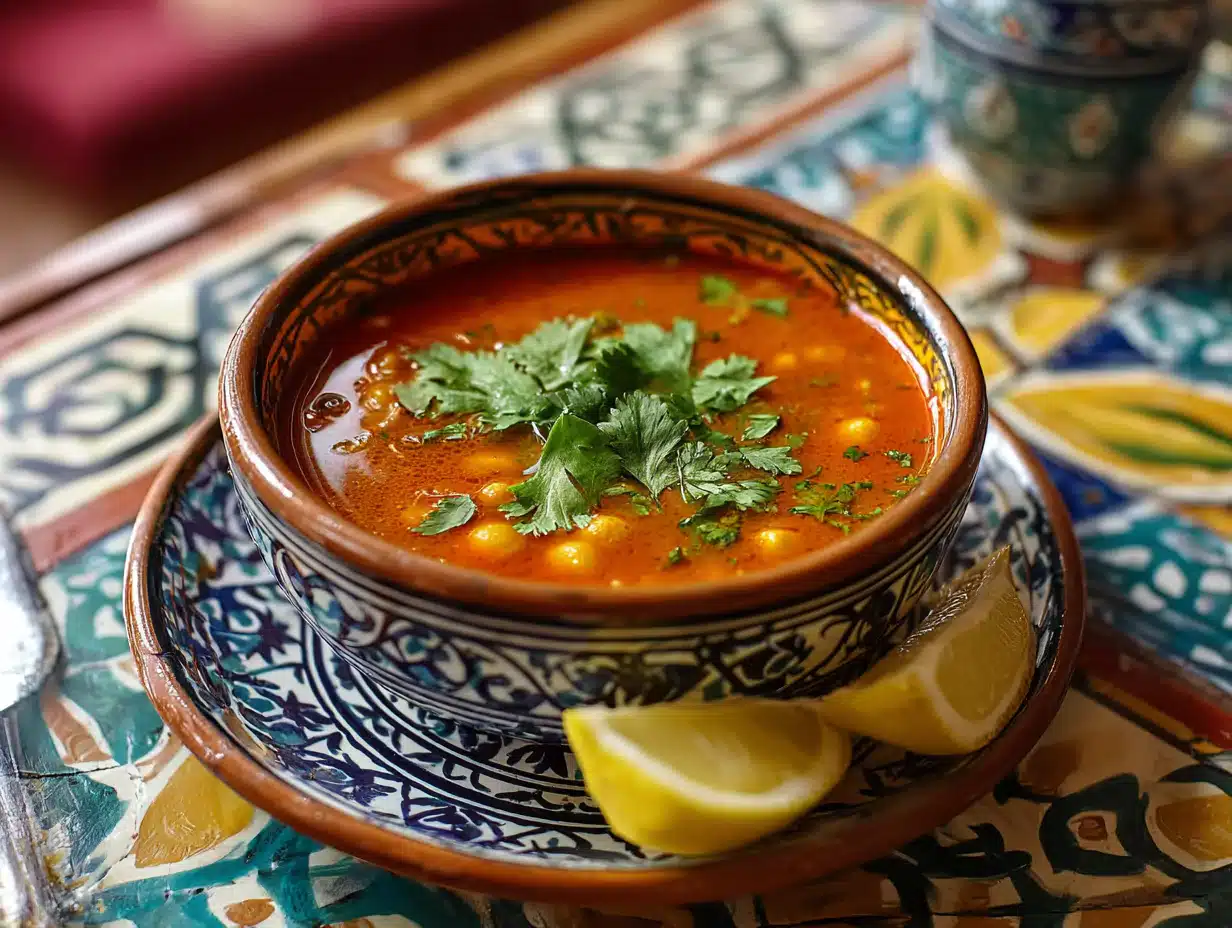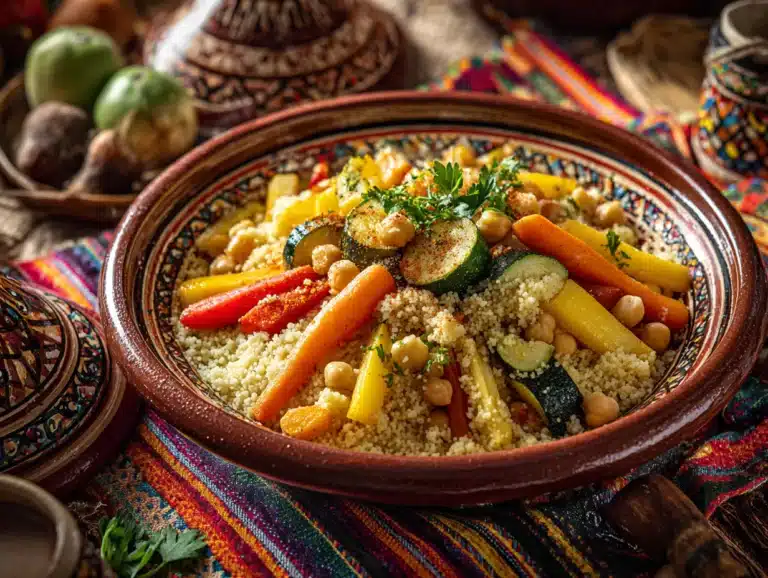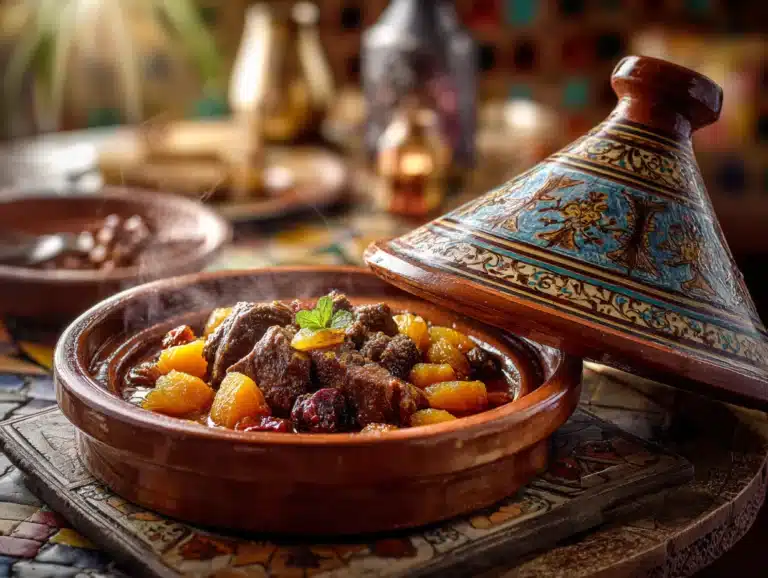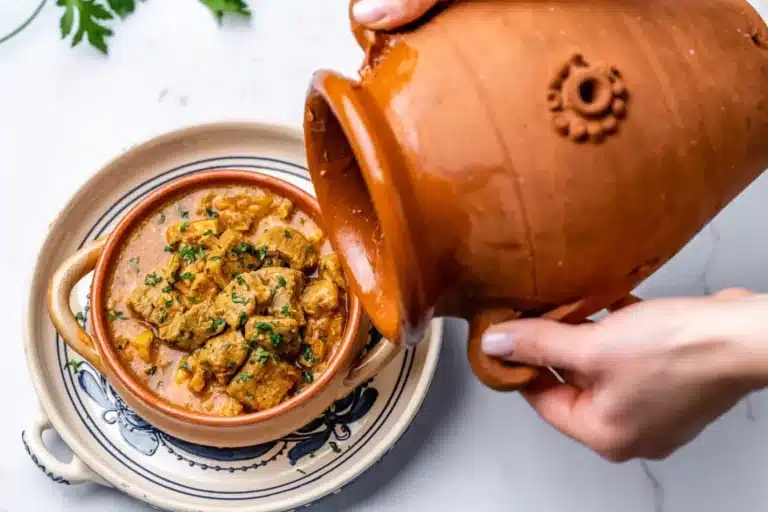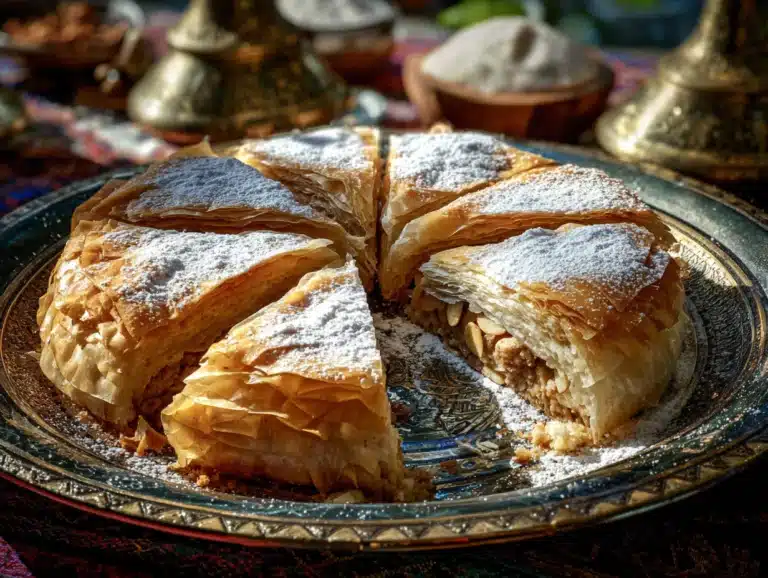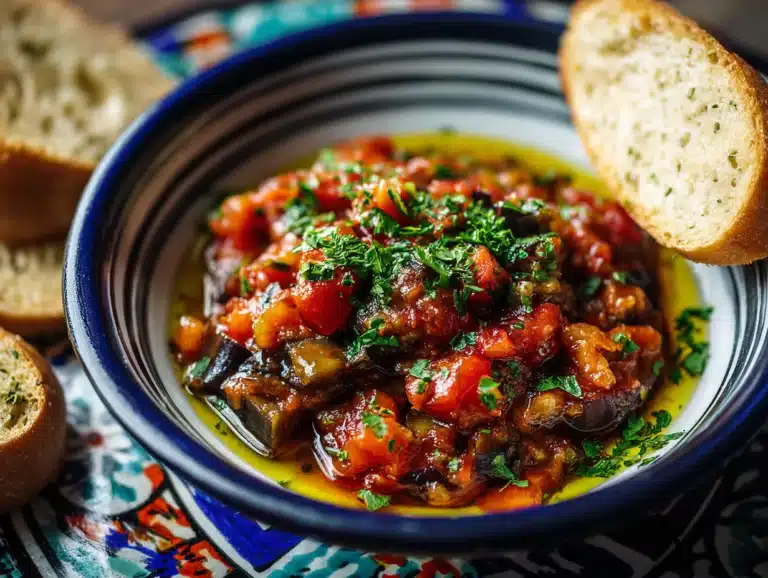Harira: Classic Moroccan Soup Recipe in 3 Simple Steps
Harira is Morocco’s beloved traditional soup, a hearty blend of tomatoes, lentils, chickpeas, and aromatic spices that serves as both comfort food and ceremonial dish. This nourishing moroccan soup is especially popular during Ramadan for breaking the fast, offering the perfect balance of protein, fiber, and warming spices to satisfy hunger and restore energy after a day of fasting.
Overview of Moroccan Cuisine
Moroccan cuisine represents a magnificent fusion of Berber, Arab, Mediterranean, and Andalusian influences, creating one of the world’s most aromatic and flavorful culinary traditions. The foundation of moroccan food recipes lies in the masterful use of spices like cumin, coriander, cinnamon, and ginger, combined with fresh herbs such as cilantro and parsley.
Traditional moroccan recipes often feature slow-cooked stews, fragrant tagines, and nourishing soups that bring families together around shared meals. The cuisine emphasizes fresh, seasonal ingredients and time-honored cooking techniques passed down through generations.
Best Time to Cook This Dish
Harira soup shines brightest during cooler months when its warming properties provide comfort against chilly evenings. However, this versatile moroccan lentil soup is enjoyed year-round, particularly during religious observances.
The soup reaches peak popularity during Ramadan, when it’s traditionally served at iftar (the evening meal that breaks the fast). Many Moroccan families also prepare harira during other special occasions, winter gatherings, and whenever they crave a nutritious, soul-warming meal.
Seasonal Considerations
- Winter: Perfect for cold days when hearty warmth is needed
- Ramadan: Essential for breaking the fast with proper nutrition
- Special occasions: Weddings, celebrations, and family gatherings
Cultural Significance of Harira
In Moroccan culture, harira represents far more than just a soup—it embodies hospitality, tradition, and communal bonding. The dish holds special significance during Ramadan, where it’s often the first food consumed after a day of fasting, providing essential nutrients and gentle nourishment for the stomach.
The preparation of moroccan harira traditionally brings families together, with recipes passed down from mothers to daughters, each family adding their own subtle variations. The soup’s rich, complex flavors symbolize the diversity and richness of Moroccan culture itself.
During religious holidays and special celebrations, serving harira demonstrates care and hospitality toward guests. The dish’s ability to feed large groups economically while providing substantial nutrition has made it a cornerstone of Moroccan home cooking.
Ingredients Needed
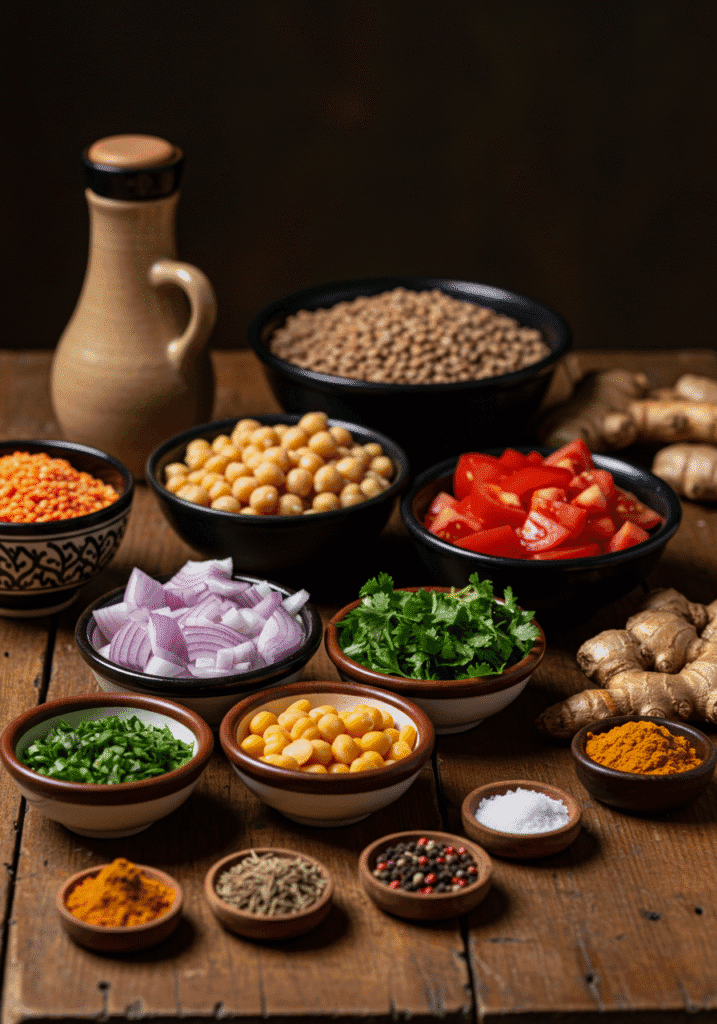
Main Ingredients
- 1 cup brown lentils (عدس in Arabic) – rinsed and sorted
- 1 cup chickpeas – soaked overnight or 1 can (15 oz), drained
- 1 lb lamb or beef – cut into small cubes (optional for vegetarian version)
- 1 large onion – finely diced
- 3 celery stalks – chopped
- 1 cup fresh tomatoes – peeled and chopped, or 1 can (14 oz)
- 1/4 cup tomato paste
- 1/2 cup fresh cilantro – chopped
- 1/2 cup fresh parsley – chopped
- 2 tbsp olive oil
Spice Blend
- 1 tsp ground ginger
- 1 tsp ground cinnamon
- 1 tsp ground turmeric
- 1/2 tsp ground black pepper
- 1 tsp salt (adjust to taste)
- 1/4 tsp saffron threads (optional but recommended)
For Thickening
- 2 tbsp all-purpose flour
- 1/4 cup water
- 2 large eggs – beaten
- 2 tbsp lemon juice
Garnish
- Fresh cilantro and parsley
- Lemon wedges
- Dates for serving alongside
Ingredient Substitutions
- Vegetarian option: Omit meat, add extra vegetables like carrots or sweet potatoes
- Lentil alternatives: Red lentils cook faster but may break down more
- Meat alternatives: Chicken, turkey, or even fish can substitute for lamb/beef
Step-by-Step Instructions
Preparation (15 minutes)
- Soak chickpeas overnight in plenty of water, or use canned chickpeas for convenience
- Prepare vegetables by dicing onion, chopping celery, and preparing fresh herbs
- Mix flour with water to create a smooth slurry for thickening
Cooking Process (45-60 minutes)
Step 1: Brown the Meat (if using)
Heat olive oil in a large, heavy-bottomed pot over medium-high heat. Add cubed meat and brown on all sides, about 5-7 minutes. This step adds depth of flavor to the moroccan harira soup.
Step 2: Build the Flavor Base
Add diced onions to the pot and cook until translucent, about 5 minutes. Stir in celery, ginger, cinnamon, turmeric, and black pepper. Cook for 2-3 minutes until fragrant.
Step 3: Add Tomatoes and Paste
Incorporate chopped tomatoes and tomato paste, stirring well to combine. Cook for 5 minutes, allowing the tomatoes to break down and meld with the spices.
Step 4: Add Liquids and Legumes
Pour in 8 cups of water or broth. Add soaked chickpeas and lentils. Bring to a boil, then reduce heat to low and simmer covered for 30-40 minutes until legumes are tender.
Step 5: Add Fresh Herbs
Stir in half of the chopped cilantro and parsley. Add saffron if using. Continue simmering for 10 minutes.
Step 6: Thicken the Soup
Gradually whisk in the flour-water mixture, stirring constantly to prevent lumps. Simmer for 5 minutes until the soup thickens slightly.
Step 7: Final Enrichment
In a small bowl, whisk beaten eggs with lemon juice. Slowly drizzle this mixture into the simmering soup while stirring continuously to create silky ribbons. Remove from heat immediately.
Step 8: Final Seasoning
Taste and adjust salt, pepper, and lemon juice as needed. Stir in remaining fresh herbs.
Cooking Tips & Tricks
Authentic Flavor Secrets
- Toast whole spices before grinding for deeper flavor
- Use good quality saffron – a little goes a long way
- Don’t rush the browning of meat for maximum flavor development
- Taste and adjust seasoning throughout the cooking process
Texture Perfect Techniques
- Soak chickpeas overnight for better texture and faster cooking
- Stir the flour mixture gradually to avoid lumps
- Add eggs slowly while stirring to create silky texture without scrambling
Time-Saving Tips
- Use canned chickpeas to reduce cooking time by 30 minutes
- Prep vegetables ahead and store in refrigerator
- Make a double batch and freeze portions for later
Common Mistakes to Avoid
- Don’t add eggs too quickly or they’ll scramble
- Avoid overcooking lentils as they’ll become mushy
- Don’t skip the browning step for meat – it adds crucial flavor
Serving Suggestions
Traditional Accompaniments
Harira is traditionally served with dates and chebakia (honey-sesame cookies) during Ramadan. The sweetness of dates provides a perfect contrast to the soup’s savory richness.
Bread Pairings
- Khubz (Moroccan flatbread)
- Msemen (flaky Moroccan pancakes)
- Crusty French bread for international diners
Modern Serving Ideas
- Garnish with a dollop of plain yogurt for creaminess
- Serve with harissa on the side for heat lovers
- Accompany with a simple Moroccan salad of tomatoes and cucumbers
- Pair with mint tea for an authentic Moroccan dining experience
Presentation Tips
- Serve in deep bowls to showcase the soup’s rich color
- Garnish with fresh herbs and a lemon wedge
- Provide small spoons for the chunky ingredients
Storage & Leftovers
Refrigeration
Harira keeps well in the refrigerator for up to 4 days when stored in an airtight container. The flavors often improve overnight as the spices meld together.
Freezing Instructions
This moroccan chickpea soup freezes beautifully for up to 3 months. Freeze in portion-sized containers for easy reheating. Note that the texture may change slightly after freezing, but the flavor remains excellent.
Reheating Tips
- Stovetop: Reheat gently over medium-low heat, stirring occasionally
- Microwave: Heat in 30-second intervals, stirring between
- Add liquid: If the soup has thickened too much, add water or broth to reach desired consistency
- Refresh herbs: Add fresh cilantro and parsley when reheating for best flavor
Leftover Transformations
- Use as a base for Moroccan rice by adding cooked rice
- Transform into a hearty stew by reducing liquid and adding vegetables
- Serve over couscous for a complete meal
Common FAQs
Can I make harira vegetarian?
Absolutely! Simply omit the meat and add extra vegetables like carrots, sweet potatoes, or zucchini. The soup will still be rich and satisfying thanks to the lentils and chickpeas providing protein.
What if I can’t find saffron?
While saffron adds authentic flavor and beautiful color, you can substitute with a pinch of turmeric for color or simply omit it. The soup will still be delicious.
How do I prevent the eggs from scrambling?
The key is to temper the eggs by mixing them with lemon juice first, then adding the mixture very slowly to the soup while stirring constantly. Remove from heat immediately after adding.
Can I use red lentils instead of brown?
Yes, but red lentils cook much faster and tend to break down more, creating a different texture. Reduce cooking time by about 15 minutes if using red lentils.
Is harira gluten-free?
Traditional harira contains flour for thickening, making it not gluten-free. You can substitute with cornstarch or arrowroot powder mixed with water for a gluten-free version.
How spicy is harira?
Traditional harira is mildly spiced rather than hot. The warmth comes from ginger and cinnamon rather than chili peppers. You can add harissa or cayenne pepper if you prefer more heat.
Conclusion
This traditional harira recipe brings the authentic flavors of Morocco to your kitchen, offering a perfect blend of nutrition, comfort, and cultural richness. Whether you’re observing Ramadan, seeking a warming winter meal, or exploring moroccan cuisine recipes, this hearty soup delivers satisfaction in every spoonful.
The beauty of harira lies not just in its complex flavors, but in its ability to bring people together around the table. Each bowl represents centuries of Moroccan culinary tradition, adapted for modern kitchens while maintaining its authentic soul.
Ready to experience the magic of Moroccan cooking? Try this harira recipe today and discover why it’s been beloved for generations! Share your results with family and friends, and don’t forget to explore our other authentic moroccan recipes for a complete culinary journey.
Ready to experience the magic of Moroccan cooking? Try this harira recipe today and discover why it’s been beloved for generations!
🍲 Take Action Now:
- 📌 Save this recipe to your favorites for easy access
- 📸 Share your creation on social media using #AuthenticHarira
- ⭐ Rate this recipe below and let us know how it turned out
- 📧 Subscribe to our newsletter for weekly Moroccan recipe updates
- 🔗 Explore more authentic Moroccan tagine recipes and traditional desserts
Join our community of 50,000+ home cooks who are mastering the art of Moroccan cuisine. Get exclusive recipes, cooking tips, and cultural insights delivered straight to your inbox!
FAQs
How long does it take to make harira from scratch?
Including prep time, harira takes about 1 hour and 15 minutes to make from scratch. If using pre-soaked chickpeas or canned ones, you can reduce this to about 45 minutes.
Can I make harira in a slow cooker?
Yes! Brown the meat and sauté aromatics first, then transfer everything except eggs to a slow cooker. Cook on low for 6-8 hours, then stir in the egg mixture during the last 10 minutes on high.
What’s the difference between harira and other Moroccan soups?
Harira is unique for its combination of legumes, meat, and the distinctive egg-lemon finish that creates its characteristic silky texture. It’s heartier than most Moroccan soups and has ceremonial significance.
Can I prepare harira ahead of time?
Harira can be made up to the point of adding eggs, then refrigerated for up to 2 days. Reheat gently and add the egg mixture just before serving for best results.

